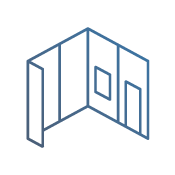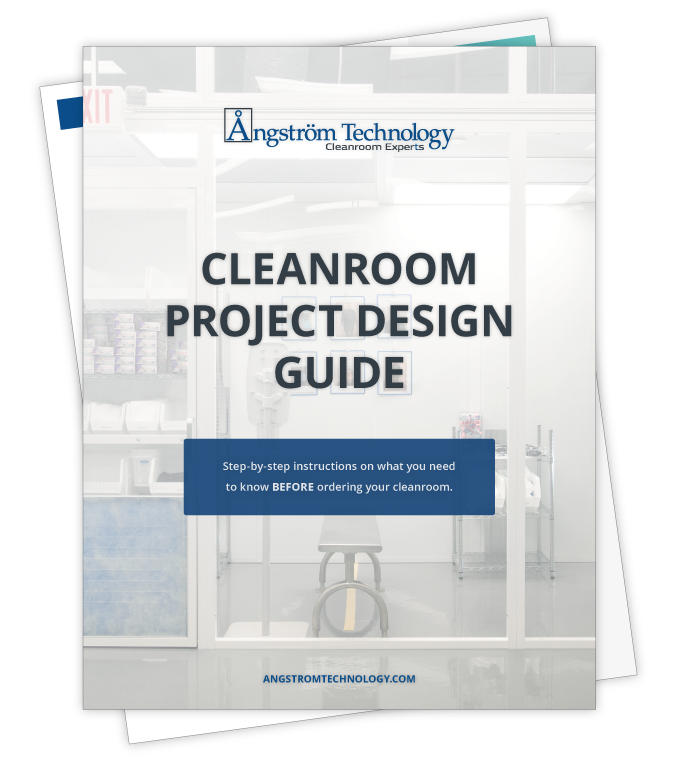PLASTICS INDUSTRY CLEANROOMS
Angstrom Technology designs, builds, and installs cleanrooms for a wide variety of industries, from biosafe cleanrooms for medical research to industrial automotive and plastics manufacturing cleanrooms. Our modular cleanrooms are versatile, efficient, and highly customizable to your unique application. They can make use of your existing space and be free-standing or connect to existing walls and systems within your facility.
In the plastics industry, quality is critical. Whether you’re manufacturing for applications in automotive, aerospace, medical, or another of plastic’s diverse uses, a controlled cleanroom environment is essential for the safe and efficient production of high-quality plastic products.
Angstrom Technology understands that each application in the plastics industry has specific needs for cleanliness determined by the cleanroom classification or other industry standards. Those needs will influence the ideal cleanroom design to increase cleanliness, safety, and productivity in your facility. The added efficiency of modular assembly means your cleanroom will be made just for you, and can be up and much quicker than an on-site build.
To get started designing your cleanroom for use with plastics, reach out to Angstrom Technology. Our experienced design engineers can help create the ideal cleanroom for your application.
What are Plastics Industry Cleanrooms?
Plastics industry cleanrooms are used for the research, development, and assembly of plastic components in a controlled environment. Plastics play a valuable role in many industries, from packaging and construction to automotive parts and medical devices.
Depending on the plastic’s application and the importance of sterility for that use, the processes to manufacture it can require significant regulation. Plastics used in the composition of medical devices, for example, require more extreme care and cleanliness during the manufacturing process than plastic used for less sensitive purposes, such as that used to make furniture. While some plastics can be sterilized after manufacturing is complete, some plastics or components cannot hold up to heavy sterilization and instead must be developed in a clean environment.
A cleanroom is necessary to control the environment where the plastic is manufactured to ensure product consistency and consumer safety, especially in those applications where the presence of contaminants could present a risk to a patient, employee, or consumer. In a controlled cleanroom space, environmental factors are monitored to limit airborne and surface contamination to an acceptable degree, as outlined by the cleanroom classification.
Plastics Industry Cleanroom Applications
Plastics manufacturing has a place in an abundance of applications, including parts for machines, furniture, automobiles, and aircraft. Plastic is used in food packaging, technology, and even as a building material in construction. In every major manufacturing industry you can find something made or designed using plastic.
The medical industry is also a major consumer of plastic. From the plastic bags used to keep pharmacological products and surgical equipment clean to the tools and medical devices used by surgeons and staff, doctors and patients alike rely on the sterile production of plastics for health and safety.
Plastics Manufacturing Methods
Just as plastic can be used in a variety of ways to meet many demands, there are also many ways to manufacture, or mold, the material to the desired shape, thickness, and purpose. The four main plastic molding methods are:
- Injection Molding: The most common manufacturing method, plastic is injected into a set mold. The malleable plastic material fills the shape and cools to form the completed component.
- Extrusion Molding: Melted plastic is pushed through a die to give it shape. This method is commonly used to make seals and pipes.
- Rotational Molding: To make parts for cars and furniture with rotational molding, plastic powder is put into a mold, heated, and then rotated until the plastic creates an outer layer and leaves a hollow interior.
- Blow Molding: A blow mold uses air pressure to shape melted plastic around a parison (pre-shaped hollow plastic piece) that is contained inside. The parison creates a cavity where the plastic has expanded around it. This method is often used to make hollow containers and bottles.
All of these manufacturing processes require careful control to make sure the plastic is heated, cooled, and molded correctly without defects or contamination that could cause it to fail. Changes in temperature, humidity, pressure, static, or other factors could have serious consequences in plastics manufacturing — especially if the plastic products have sensitive or complex purposes. Fortunately, the controlled environment of a cleanroom can limit the ability of these forces to affect manufacturing processes.
Cleanrooms can provide control over humidity, particles, contamination, pressure, and temperature to ensure consistency and cleanliness in your products and testing. In plastics manufacturing, cleanrooms are regulated by classification standards that set the allowed number of particles at different sizes, and also govern necessary air changes to make sure the space stays clean.
Plastics Industry Cleanroom Classifications
Plastics industry cleanrooms are regulated by cleanroom classifications set by the International Standards Organization, or ISO. The ISO classifications designate the allowed contaminants in a cleanroom environment, filtered by particle size and number.
ISO 14644-1 is divided into 9 classes, where Class 9 is equivalent to room air and Class 1 is the cleanest possible environment. Most plastics manufacturing cleanrooms fall under the requirements of ISO Classes 7 or 8, meaning a maximum number of particles of .05μ or greater in the air ranging from 352,000 to 3,520,000. Some plastics manufacturing applications that are especially sensitive to contamination or involve more complex assembly may require a more stringent cleanroom classification, such as ISO Class 5 or 6.
As the classification decreases, a cleaner space is required. Plastics industry cleanrooms that are required to have a high level of control must continually change the air to remove contaminants and push clean air into the space. They require the implementation of an efficient HVAC and HEPA filtration system to ensure the air is changed consistently and effectively and maintained at a stable temperature and humidity level.
Other industry-specific standards (such as ISO 9001, ISO/TS 16949, or ASTM E2352) may be in place to ensure your cleanroom is properly equipped to manage the unique threats to productivity and safety it may face.
With complete control over the manufacturing space managed by your cleanroom — including filtration, temperature, humidity, and static — you’ll be able to focus on your work. Your cleanroom will also be fully customized to contain all the equipment, fixtures, and tools you’ll need to be successful. Additionally, if your project needs change, Angstrom Technology’s modular cleanrooms have the advantage of being easily modified or reconfigured. They can even adjust to a new, more stringent standard if you need to upgrade at any time — and not slip in quality or efficiency.
Plastics Industry Cleanroom Design
Plastics industry cleanrooms are designed to establish as much control over the manufacturing process as possible, particularly to maintain a favorable environment. Without control over the environment, contaminated products may not be effective or could fail and have severe consequences for consumer health and safety. While cleanrooms can’t replace the need for proper sterilization of plastic products, they can ensure proper control during the manufacturing process — which is especially important for products that can’t withstand sterilization procedures or have sensitive uses.
Plastics industry cleanrooms must be able to maintain a sterile environment while allowing normal operating procedures to occur with cleanliness and efficiency. They should have adequate room for personnel to move, as well as cranes, carts, and other transport equipment. All cleanrooms need to design connections for water, electrical, and air handling systems, as well as create space for storage for cleaning supplies and gowning areas. Plastics manufacturing cleanrooms must also accommodate large equipment, such as plastic injection molding machines which can range in size from 50 to 1,000 tons.
With all of the vital features included, a cleanroom should only be as expansive as necessary to allow for efficient energy usage and to limit operational costs. Angstrom Technology designs, builds, and installs high quality cleanrooms to meet your project specifications, comply with all cleanroom classifications, and operate efficiently. We will work with you and your facility’s budget to set up your space with everything you need to get your cleanroom up and running as soon as possible and make your work a success.
Plastics Industry Cleanroom Systems
Angstrom Technology uses the best quality materials to construct our top-of-the-line modular cleanrooms. We offer our HardWall cleanrooms, RigidWall cleanrooms, and SoftWall cleanrooms, all of which are durable and high-quality, and can be free-standing or incorporate existing structures, walls, and HVAC and ventilation equipment.

HARDWALL CLEANROOMS
Angstrom Technology HardWall cleanrooms allow a high level of control over pressure, static, humidity, and of course, contamination; they can conform to even the most stringent cleanroom classifications required by your application.

RIGIDWALL CLEANROOMS
Our RigidWall cleanrooms are also an option for most plastics industry cleanrooms requiring a classification of ISO Class 5-8, while offering more flexibility than our HardWall options. Using a durable and heavy-duty frame, RigidWall modular cleanroom panels can be made using clear acrylic, static dissipative PVC, or polycarbonate.

softwall CLEANROOMS
SoftWall cleanrooms have the advantage of being an affordable modular option that don’t sacrifice their high performance capacity. Their extremely flexible design makes them a great choice for many plastics industry applications, particularly those that need room to grow, and can accommodate cleanroom classification standards ISO Class 4-8. SoftWall cleanrooms can fit in almost any space and are fully customizable.
Plastics Industry Cleanroom Structure
Angstrom Technology knows that cleanroom design is more than just the type of structure you choose. We design our cleanrooms to reflect the unique and evolving operations they support, with a number of options for multi-stage HEPA/ULPA air filtration systems and laminar air flow systems that can work with dedicated or existing HVAC systems. We also work with your classification standards to incorporate all the extra features you need to keep productivity and efficiency up, while minimizing or eliminating safety and contamination risks.
Plastics Manufacturing Air Filtration
A vital part of any cleanroom design involves its airflow pattern. The ideal airflow pattern is powerful, thorough, and consistent, to reduce contamination both in the air and on surfaces within the space. Every change of the air will remove particles evenly and effectively — the first time and every time. Having dedicated fan filter units and a custom airflow pattern that work with your cleanroom space will ensure that happens.
Plastics Industry Cleanroom HVAC
Your cleanroom HVAC regulates temperature and humidity levels within the manufacturing environment, not only to keep your employees comfortable, but to keep machines functioning at optimal levels and protect sensitive products and processes within the cleanroom. Fluctuations in temperature and humidity can be detrimental to productivity and your bottom line, so a reliable HVAC system is a must in any cleanroom design.
Plastics Industry Cleanroom Pressurization
Positive pressure cleanrooms are used in the plastics industry to protect the products and processes inside from contamination outside of the cleanroom. To achieve positive pressure, more air is pumped into the cleanroom than is filtered out. A positive pressure environment can effectively reduce contamination risks and improve cleanliness.
Additional Plastics Cleanroom Features
Plastics industry cleanrooms can be outfitted with whatever extra features your application needs to succeed, whether that’s the perfect cleanroom tables, ergonomic cleanroom furniture and anti-fatigue mats, standard, flow through, and other cleanroom lighting systems, electro-static discharge safe materials, or industry-specific equipment. Talk to a cleanroom design expert to make sure your cleanroom is set up just the way you’d like it.
Plastics Industry Cleanroom Services
Angstrom Technology’s cleanroom experts provide the best modular cleanrooms on the market in all phases of creation, development, and installation. From the initial design to construction, to adaptation and reconfiguration, to routine maintenance and cleaning, Angstrom Technology makes high-performance plastics manufacturing cleanrooms so you can keep working, developing, and molding.
Plastics Industry Cleanroom Design & Build
When it comes to cleanroom design, rely on the experts at Angstrom Technology. Based on your specifications and unique application, we can design the ideal cleanroom for you. Our team can build versatile layout options that will encourage productivity and accessibility. With a layout in place, we can use computational fluid dynamics to create a digital model of your cleanroom space to find the best airflow pattern for your cleanroom, reducing the strain on your cleanroom’s HVAC system and changing the air more effectively.
Angstrom Technology can assist in construction of your cleanroom, adaptation of your cleanroom site, even retrofit the cleanroom build to existing infrastructure. Our modular cleanrooms are pre-manufactured so when they arrive at your site, they can be assembled quickly and efficiently. We’ll provide straightforward instructions so you can set up your cleanroom yourself, or have our crew install it for you. We can also install industry-specific equipment so your cleanroom is up and running as soon as possible.
Reconfigure and Repurpose
If you need to upgrade, downsize, or reconfigure your existing cleanroom, Angstrom Technology can help you adapt your cleanroom to fit your revised needs and cleanroom standards. Using modular panels, a cleanroom can be expanded or condensed to accommodate new equipment, additional personnel, or a new layout. Our cleanroom experts can help create an intuitive and efficient cleanroom layout, upgrade your cleanroom HVAC system, and design an airflow pattern that works with your new space.
Maintain and Clean
Plastics industry cleanrooms require consistent evaluation to make sure they meet class standards, and that all systems perform efficiently and operate safely. In addition to routine maintenance, cleanrooms should also receive regular cleaning to reduce contaminant generation and prevent the transfer of contaminants inside the cleanroom.
If you want to make sure your space is always up to your cleanroom classification standards, Angstrom Technology can add you to our regular maintenance schedule for cleanroom HVAC service, filter replacement, deep cleaning, and more.
Whether the plastic components your company molds are for automotive, aerospace, medical devices, or something else, Angstrom Technology can design, build, and install cleanrooms to meet any classification requirements, and can ensure yours can meet even the most stringent standards and maintain optimal cleanliness at all times.
To discover more about Angstrom Technology’s cleanroom offerings, as well as our cleanroom design, maintenance, and installation services, download our Cleanroom Design Guide or give us a call to speak with an engineer about your cleanroom needs.
Get Instant Access to Our Cleanroom Design Guide
The Most Comprehensive Guide for Cleanrooms and Modular Offices

